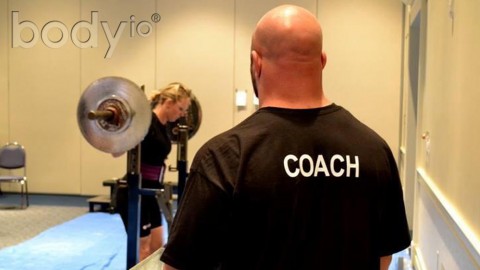uring my work with clients, as well as from talking to and observing people from day-to-day, I’ve noticed that we’ve become a culture of extremes: all or nothing. We tend to take something to the utmost extreme or we coast along in our comfort zone, unwilling to make even the slightest change. For the individual, extremes are often the fast roads to failure, not success. Success is typically found somewhere in the middle, but it seems as though we’ve forgotten what that looks like. For that reason, I want to discuss some of the most common extreme approaches to which I see people fall victim and guide readers towards the middle ground–the path to long-term sustainable success.
Goals
Every transformation starts with setting goals. We need goals or else we can easily lose sight of why we are working so hard and why it’s important to us. Time and time again, I see two very common trends. Some people want to do whatever it takes to undergo an extreme body transformation and compete in a bikini/bodybuilding show within six months. Others simply want to lose a few pounds, and then stop. They’re not exactly sure why, but they think that losing a few pounds and then going back to their old ways will somehow be life-altering.
Middle Ground: Focus on gradually adopting a long-term lifestyle change. To do that, aim for improved health and energy levels and let your body transform at a reasonable pace. Once you have your basics covered, you are getting results, and you no longer struggle with being consistent, then you can set a new goal. Maybe that goal is competing in a bikini competition and maybe it’s not. Either way, get there gradually.
Attitude
Your attitude is a set way of thinking about something that is reflected in your behavior. There are two attitudes that I encounter most often: superhero attitudes and self-defeating ones. The problem with believing that you are a superhero is that you set unrealistic expectations for yourself, so when you come up short, you have to deal with the negative consequences. On the flip side, some people expect to fail before they even start trying. This is very common if you have a history of yo-yo dieting. Nothing seems to work, so you prepare yourself for failure to prevent further disappointment.
Middle Ground: Accept that you are NOT a superhero and learn to be okay with that. Perhaps you have yo-yo dieted without success in the past, but you are now ready to approach this with a different attitude and learn what it takes to reach your goals. Strive to do your best each day, but understand that it won’t always be smooth sailing along the way. Don’t beat yourself up over this. Tomorrow is a new day and this is a long journey.
Exercise
Exercise extremes most often fall into two categories: frequency and type.
Frequency extremists are people who drag themselves to the gym a few times a week between Netflix® marathons vs. the people who refuse to take any time to rest and recover properly.
Middle ground: Most people excel with three or four resistance training sessions and one or two HIIT sessions per week (if necessary, based on your goals). Also, don’t overlook the benefits of going for a leisurely walk on a regular basis. Walking is the perfect activity to fill voids on non-training days or in between your favorite TV shows.
Perhaps you’ve dialed in your training frequency. You’ve been consistent with an optimal training schedule, but your physique hasn’t changed, and it’s been years! You likely fall into one of the following categories.
Mash-up master. You go to the gym on a regular basis and when you get there, you just wing it and do whatever you feel like: probably a combination of ¼ squats, bench presses and bicep curls. Whatever it is, you have no program, no periodization, no progressive overload, and no plan. It shows, because you’ve also made no progress.
On the flip side, maybe you have what I call training ADD. These people meticulously follow a program and track every detail, but if they don’t get incredible strength, hypertrophy, or fat loss results in 60 days, they jump to an entirely new plan altogether.
Middle ground: Make sure your training program is appropriate based on your primary goal. Stick with it. As you progress, the general program will likely still be appropriate, but you will have to switch up your accessory exercise choices on a regular basis and pay attention to intensity, volume, progressive overload and diet!
Diet
I could have written an entire article just about diet extremes, but I’m going to focus on the two scenarios that I observe most often.
Calorie Tracking
I can’t believe how many people I meet who have tracked everything they have had to eat or drink for the past 365 days. While at first this seems like a good way to pay attention to your caloric intake, these people typically end up being extremely stressed out and they panic when they have to eat something without the ability to record the data. Other people, however, think they never have to pay any attention to how much they eat. You know the type. They can’t lose weight, but they’ve also never considered eating less, or the guy who wants to gain muscle but only eats 1200 calories per day.
Middle ground: You don’t have to use a calorie-tracking device 365 days a year, but it can be a useful tool to help plan your meals, heighten your food awareness, and learn how to eyeball your portions. Use it when necessary and trust yourself to eat without it. The body is too complex to be worrying about every last gram or calorie, but you should be in a reasonable range based on your goals.
Clean Eating vs. Junk
This is very common with people following Carb Nite® or Carb Backloading™. I hate the terms “clean” and “junk,” but they seem to be what people relate to. There tends to be two kinds of people: the moderate “clean” carbers and the overboard “junk” ones.
Middle Ground: The amount of carbs you can tolerate is an individual prescription and will likely change as your body composition changes.
To get the best insulin spike, choose high GI carbohydrates. There are a wide variety of choices, ranging from single ingredient starches to pastries and we now have access to Carb Shock™. The type of carbs you choose is entirely up to you. Some people like to keep their Carb Backloads clean throughout the week and eat junk on the weekend; this is a common way to create a pattern of flexible eating. Others use a combination of starches and sweets with each backload. For people using Carb Nite, some have cleaner and more controlled Carb Nites 3x/month and one Carb Nite each month that is random and unplanned. What you can personally get away with requires experimentation.
I hope this article helps you or someone you know identify an extreme path that they might be on and how they might find more success in choosing the middle ground.
For those of you who are following The Carb Nite Solution, I’ll leave you with an example of my Carb Nite.
Carb Nite Kickoff: A whey protein shake with Carb Shock and a small low-fat high GI treat. Pancakes and syrup or a bowl of cereal are my favorite options.
Dinner: Starchy carbs and protein for my main meal, followed by a small sweet dessert. Stir-fry, ribs & rice, pizza, and sushi are my most common choices. I typically have 5g of Leucine with this meal.
Last Meal: I have whatever I want or what I’ve been craving. Cheesecake, ice cream with cookies/brownies, or cornbread are my most common picks.













